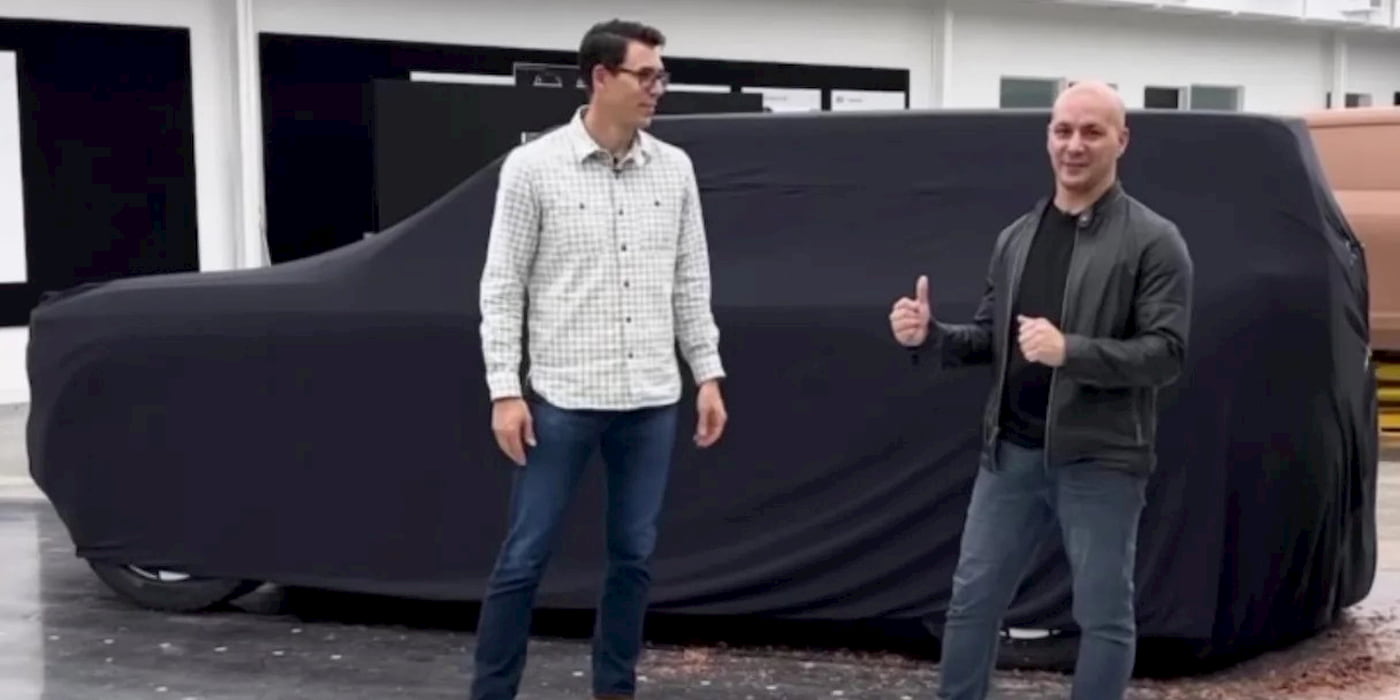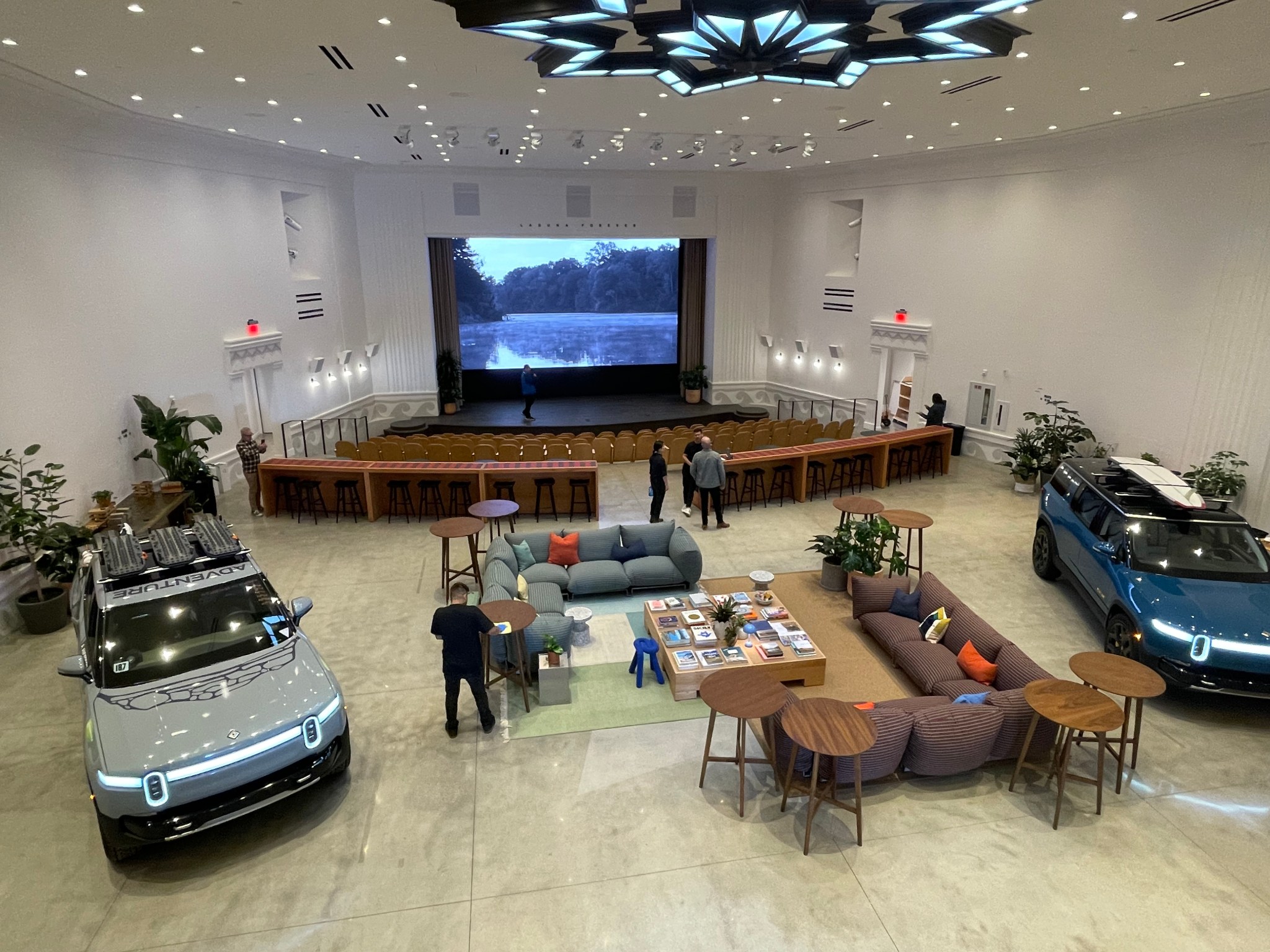
Rivian today announced that the company is going to show the world the smaller, more value-focused R2 at their Laguna showroom on March 7th. We uncovered the launch event date and location earlier, but the move is now official and could include some surprises.
Rivian recently opened a new flagship store in Laguna Beach at the site of a historic theater, first opened in 1936 which had been boarded up. Led by Rivian design VP Denise Cherry, the company restored the building into a retail and event space with a homage stage and theater screen seen below.

Rivian’s plans were leaked earlier via the Laguna Beach town government website, which published Rivian’s intention to use an adjacent lot for the event. Those plans were subsequently removed either for secrecy or because of a change of plans.

Laguna Beach is 17 minutes away (depending on traffic) from its Irvine headquarters, making it a relatively easy commute for its executives, including CEO RJ Scaringe.
Electrek will be on site, and Rivian told us a bit about what to expect:
Our Founder & CEO RJ Scaringe will lead a keynote presentation about the future of Rivian products. Following, there will be first looks and time with Rivian leads.
Rivian
The event announcement came with a small “beachy” animation shown below.
We have seen the R2S(?) undercover earlier on a Rivian Instagram Story…

…which lines up well with a recent patent application showing us new smaller lights on the front facia of what looks like an R2S.

Rivian R2 price
Rivian was less tight-lipped about the price of this vehicle, which will be produced in its new Georgia facility focusing more on adventure aesthetics.
CFO Claire McDunnaugh told analysts:
From an overall price vantage point, we see this really targeting the MEB of the broader midsized SUV crossover market. So straddling were the broader ranges of $40,000 to $60,000 area in aggregate. And so that also creates a nice stretch for the brand as you see R1 with an average selling price starting at $73,000, so this lives right below that as we think about the opportunity set available to Rivian. And as we think about R2, right, R2 really means on the brand and ethos of what R1 has started. R1 created flagship vehicle that’s phenomenal on-road, off-road. I’ve climbed boulders in R1s having never driven off-road before. It is a confidence-inspiring vehicle. And so as you think about what is the translation to R2, right? It still maintains some of that adventure aesthetic, but it’s also contemplating and thinking about how can we really focus on where we’re investing in, in capabilities that allow us to maintain that more affordable price points, and therefore, a larger addressable market for the vehicles themselves. So we’re spending a lot of time in the studio on some of those key trade-offs today, but wanting to make sure it truly has some of that Rivian brand essence embedded in it as well.
The whole June interview is worth a read or a listen, but more on how Rivian is thinking of the R2:
Emmanuel Rosner
In what ways will it be different from the R1 in terms of content, but also manufacturing process? Like what lessons have you learned from R1 in order to get confidence you can manufacture and sell R2 profitably?
Claire McDonough
So first, one of the key differences is starting place with suppliers. So we talked a little bit about, right, where we were in 2018, 2019, relative to the work that we’ve been conducting over the course of the last 2 years to get that – those material costs down. I hear we’re starting from a very different position of negotiations as it pertains to the R2 platform and the size and skill that, that platform will become over time for Rivian. I’m not just in North America, but globally as well. So for us, right, starting and establishing with that lower material cost is critically important. And one of the key areas of focus for us is how do we leverage the continued progress that we’ve made in some of our key technologies. So whether it’s the Enduro drive unit that becomes more of sort of a sister platform for R2, whether it’s in network architecture, that will be leveraged as we think about the transition to R2, we have good visibility into the road map that’s bridging us to that lower cost base today as we think about what’s currently established in our R1 pipeline and portfolio as a whole. And then the other key for us is really the – I would say there is sort of good interplay between our manufacturing engineering teams, our operations teams and our product development teams, right? That creates that healthy tension of the best part is no part. The best weld is no weld. So how do we create an environment that’s challenging and pushing from a true first principles approach at design efficiency for where R2 could be.
Emmanuel Rosner
And as we think about the EV landscape in 2026 and beyond, which is around the time frame you’re starting R2 production, how are you envisaging the competitiveness of R2 vehicles in pricing and cost of goods sold? Where do you see – well, I guess I’ll leave it at this. It feels like this could already be a fairly crowded field by then.
Claire McDonough
We think that as you look at this sort of MEB of the market, one of the things that’s incredibly important is technology, right? In the premium end of the space, you can utilize premium interiors to create sort of an experience for a customer. When you get down to these lower price levels, it’s really how you think about the brand positioning, how you think about the UI/UX experience for the customer, and how you think about the leverage and opportunity set that we have with all of these cross-platform investments that are leveraged over this new platform for us. And that’s where I think we will continue to shine. We also, as you look at R1, have built a really unique design aesthetic as well, right? They are very noticeable when you’re driving down the road. And I think the opportunities that we have as well is to continue to allow R2 to stand out and really sort of lean on some of that success that we’ve brought to market with R1.
Rivian’s R2 vehicles should qualify for the full $7500 US tax subsidy which could lower the starting price to $32,500 or less with state and other incentives.
Electrek’s take:
Top comment by Chris
I assume that the shape does affect range and efficiency somewhat, but it is much more appealing to me than the more aerodynamic egg shaped CUVs
The R2 platform will allow Rivian to enter a lower cost, higher volume market, which includes EVs like Tesla’s Model Y, but be more rugged and off-road capable. Right now, there are lots of EV CUV-type vehicles, but few are adventure-focused.
Pricing and timing will be important here, but Riivian obviously sees a path to completion because they are also risking “Osbourne effecting” their bigger R1S lineup, which is currently seeing 3-6 month wait times.
Also, a big question is whether or not Rivian sees a path to a smaller R2T EV pickup truck, something I really think the market needs and could compete with the popular Ford Maverick. If done right, this could be Rivian’s biggest seller.
The smaller platform could also see its way into smaller adventure station wagon vehicles which could really target the Subaru market.
FTC: We use income earning auto affiliate links. More.




Comments